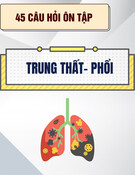
Morphology, micromorphology and physicochemical properes of Annona squamosa L. (Annonaceae) leaves from Vietnam112Do Thi Anh Thu, Tran Anh Vu, Duong Nguyen Xuan Lam,111,* Ho Thi Thach Thuy, Vo Hien Vinh and Ly Hong Huong Ha 1Hong Bang Internaonal University, Vietnam2University of Medicine and Pharmacy at Ho Chi Minh City, VietnamABSTRACTIntroducon: In everyday life, nature has given us countless useful medicinal plants. Among the common plants in Vietnam, the custard apple (Annona squamosa L.) has not been mainly used as a fruit but also tradionally as a medicine. However, studies on morphological characteriscs remain limited in Vietnam as well as around the world. Objecve: Determine the morphological and microscopic characteriscs, and physicochemical features of A. squamosa leaves. Materials and methods: A. squamosa leaves, morphological research process (analysis and photography), microscopic analysis process (staining leaf microscopic specimens and microscopy), physicochemical properes (described in Vietnamese Pharmacopoeia V). Results: The characteriscs of A. squamosa leaves were described in detail such as morphology, cross-secons, leaf powder composion, and purity of herb. Conclusion: The morphological, microscopic components and components in medicinal powder will help create the basis for building tesng standards for this medicinal plant in the future as well as support further research on A. squamosa species in Vietnam.Keywords: Annona squamosa, morphological, micro-morphological, powder featureHerbal plants have been considered one of the important sources of medicine since the beginning of human civilizaon. The demand for natural health products such as pharmaceucals, funconal foods, and cosmecs is increasing.Natural-derived drugs are recognized to be effecve and play a very important role in human disease treatment methods. In daily life, nature has provided us with countless useful medicinal plants. Some plants are both a source of food and have remarkable healing and disease-prevenon properes. Among the very popular plants in Vietnam, Custard-Apple (Annona squamosa L.) is a plant mainly used for fruit, but folk medicine also uses it as a medicine [1].It is noteworthy that according to Indian folk medicine, the young leaves of A. squamosa have andiabec acvity. This medicine is widely used by men of tribes around the Aligarh district of Uar Pradesh, India, and the Chotanagpur district of Bihar, India. Villagers in these places take a mixture of 4-5 new young leaves combined with 5 black peppercorns (Piper nigrum) chopped in the early morning to treat diabetes with good results [2].Many documents and published arcles on the extract and isolated acve ingredients from A. squamosa leaves have hypoglycemic, hepato-protecve, anoxidant, antumor, and an-lice effects. These effects of this medicinal plant are related to the presence of alkaloids, carbohydrates, essenal oils, tannins, and phenolic compounds in the different parts of the plant [3].In Vietnam, there have not been many published studies in detail on the morphology of this species as well as in the world. Therefore, this study provides informaon on morphological, micromorphological features to idenfy A. squamosa harvested in Vietnam precisely. Also, this 45Hong Bang Internaonal University Journal of ScienceISSN: 2615 - 9686 DOI: hps://doi.org/10.59294/HIUJS.VOL.6.2024.628Hong Bang Internaonal University Journal of Science - Vol.6 - 6/2024: 45-50Corresponding author: M.S. Pharm Ly Hong Huong HaEmail: halhh@hiu.vn1. INTRODUCTION






























